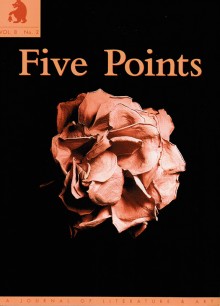Five Points, Vol. 8 No. 2
Spring 2004From Hayden Carruth, “I preferred independence, and I emphasized that in my poetry, in my prose too, I think, and in my life.”
Sample Content
Shannon Ravenel
Wild with Discovery
For a long time now, I have been reading a lot of literary magazines on a very steady basis. Every single issue, every single year since 1978. I read them at my desk at Algonquin Books of Chapel Hill and at home at night. I never board a plane without a stash of two or three in my carry-on. Once, on a train from St. Louis to Chicago, a woman in the seat next to mine tapped the copy of TriQuarterly I was reading and said, “I know about these little magazines because my husband is a poet, but you’re the first person I’ve ever seen reading one.” (She turned out to be Floyd Skloot’s first wife.)
Reading the lit mags is part of my work, of course, but it has also gotten to be a life habit. Sometimes I wonder if I didn’t inaugurate my anthology, New Stories from the South, so I’d have an excuse to keep on reading them.
I first encountered literary magazines in 1961, as a wildly ambitious secretary (known nowadays as an “editorial assistant”) in the trade editorial department of Houghton Mifflin Company in Boston. Fresh out of Hollins College and clutching an A.B. in English Literature, I wanted, with every fiber of my being, to be a fiction editor. But the closest I was getting was typing for my bosses—the fat, formidably outgoing Senior Editor, Dorothy de Santillana, and her exact opposite, excruciatingly thin, shy, and brilliant Anne Barrett (Tolkien’s U.S. editor). I loved typing their manuscript reports and their editorial letters, but doing so just made me wish all the harder that I could be typing my own. So I looked around the high-ceilinged old offices in the 19th-century brownstone on Boston Common and saw a pile of scholarly looking things lying on a shelf getting dusty. Back at Hollins, I had edited the college literary magazine but cannot remember being shown any real life models such as The Virginia Quarterly or The Sewanee Review. But Houghton Mifflin subscribed to a great many of what the staff called “the little magazines,” yet as far as I could tell, nobody ever read them.

